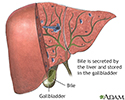Biliary atresia
Jaundice newborns - biliary atresia; Newborn jaundice - biliary atresia
Biliary atresia is a blockage in the tubes (ducts) that carry a liquid called bile from the liver to the gallbladder.
Causes
Biliary atresia occurs when the bile ducts inside or outside the liver do not develop normally. The reason why this happens is unknown.
The bile ducts help remove waste from the liver and carry salts that help the small intestine break down (digest) fat.
In babies with biliary atresia, bile flow from the liver to the gallbladder is blocked. This can lead to liver damage and cirrhosis of the liver, which can be deadly.
Symptoms
Newborns with this condition may appear normal at birth. However, jaundice (a yellow color to the skin and mucus membranes) develops by the second or third week of life. The infant may gain weight normally for the first month. After that point, the baby will lose weight and become irritable, and will have worsening jaundice.
Other symptoms may include:
- Dark urine
- Enlarged spleen
- Floating stools
- Foul-smelling stools
- Pale or clay-colored stools
-
Slow growth
Slow growth
Delayed growth is poor or abnormally slow height or weight gains in a child younger than age 5. This may just be normal, and the child may outgrow i...
 ImageRead Article Now Book Mark Article
ImageRead Article Now Book Mark Article - Slow or no weight gain
Exams and Tests
The health care provider will perform a physical exam, which includes feeling the baby's belly area. The provider may feel an enlarged liver.
Tests to diagnose biliary atresia include:
- Abdominal x-ray
- Abdominal ultrasound
- Blood tests to check total and direct bilirubin levels
- Hepatobiliary iminodiacetic acid (HIDA) scan, also called cholescintigraphy, to help determine whether the bile ducts and gallbladder are working properly
- Liver biopsy to determine the severity of cirrhosis or to rule out other causes of jaundice
- X-ray of the bile ducts (cholangiogram)
Treatment
An operation called the Kasai procedure is done to connect the liver to the small intestine. The abnormal ducts are bypassed. It is most successful if done before the baby is 8 weeks old. However, a liver transplant may still be needed.
Outlook (Prognosis)
Early surgery will improve the survival of more than a third of babies with this condition. The long-term benefit of a liver transplant is not yet known, but it is expected to improve survival.
Possible Complications
Complications may include:
- Infection
- Irreversible cirrhosis
- Liver failure
- Surgical complications, including failure of the Kasai procedure
When to Contact a Medical Professional
Call your health care provider if your child appears jaundiced, or if other symptoms of biliary atresia develop.
References
Kliegman RM, Stanton BF, St Geme JW, Schor NF. Cholestasis. In: Kliegman RM, Stanton BF, St Geme JW, Schor NF, eds. Nelson Textbook of Pediatrics . 20th ed. Philadelphia, PA: Elsevier; 2016:chap 356.
Suchy FJ. Anatomy, histology, embryology, developmental anomalies, and pediatric disorders of the biliary tract. In: Feldman M, Friedman LS, Brandt LJ, eds. Sleisenger and Fordtran's Gastrointestinal and Liver Disease . 10th ed. Philadelphia, PA: Elsevier Saunders; 2016:chap 62.
-
Bile produced in the liver - illustration
The biliary organs and duct system that creates, transports, stores, and releases bile into the duodenum for digestion includes the liver, gallbladder, and bile ducts (named the cystic, hepatic, common, and pancreatic duct).
Bile produced in the liver
illustration
-
Bile produced in the liver - illustration
The biliary organs and duct system that creates, transports, stores, and releases bile into the duodenum for digestion includes the liver, gallbladder, and bile ducts (named the cystic, hepatic, common, and pancreatic duct).
Bile produced in the liver
illustration
Review Date: 2/15/2016
Reviewed By: Neil K. Kaneshiro, MD, MHA, Clinical Assistant Professor of Pediatrics, University of Washington School of Medicine, Seattle, WA. Also reviewed by David Zieve, MD, MHA, Isla Ogilvie, PhD, and the A.D.A.M. Editorial team.

